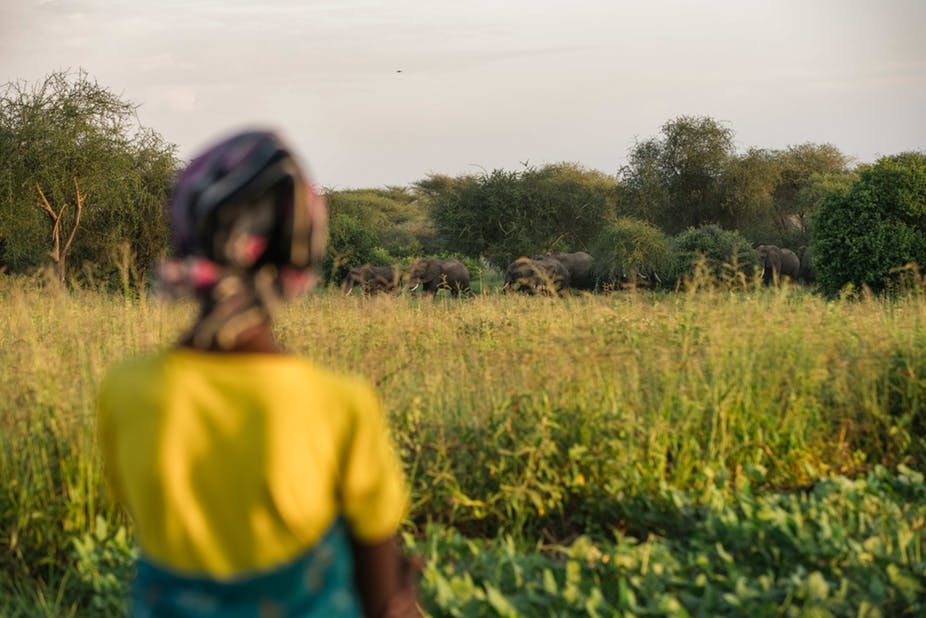By several accounts, 2018 has been a great year for community-based conservation in Tanzania.
Research papers and reports by conservation scientists and non-governmental organisations suggest that community-based interventions are popular, eagerly adopted and have positive ecological impacts.
But our research suggests that a closer look is needed.
Contrary to narratives of conservation success, we illustrate that, by and large, community-based conservation in Tanzania has spread through top-down, donor-financed implementation.
What’s more, we also question narratives of ecological success. These narratives are based on simplistic ecological concepts which misrepresent socio-ecological complexities on the ground.
We urge researchers, non-governmental organisations, funders, and the media to consider more carefully how their work affects rural communities. Inaccurate narratives can cause harm, conflict and resistance. Ultimately, they can even undermine long-term conservation objectives.
The narrative vs the reality
Research shows that many conservation initiatives in Tanzania are not eagerly adopted. In fact, some have been imposed despite resistance by local communities. Many residents fear becoming economically dispossessed, losing their land, or both.
Tanzania’s flagship Wildlife Management Area, Burunge, is a case in point. It shows that simple narratives of success quickly fall apart under critical scrutiny.
Burunge is a community-based conservation project established in the 2000s in 10 villages. In financial terms, Burunge may be called a “success”. It generates several hundred thousand US dollars in revenue per year from tourism. But, with a population of more than 30,000, Burunge’s per capita income is negligible.
More importantly, residents are expected to pay a high price in return for tourism revenues. As one of us has documented, the Wildlife Management Area is characterised by deeply divisive politics of coercive land appropriation for tourism. Residents and their livestock are kept out of dry season grazing areas so that wealthy tourists can enjoy luxury wilderness experiences.
Nonetheless, there are reports that Burunge is a successfully implemented and locally run initiative. But these reports don’t take into account that residents have been protesting against their exclusion from key livestock grazing areas since it was established. Stories of success disregard this reality of green grabbing.
Conservation biologists also make scientifically questionable claims about the alleged ecological success of conservation interventions. Such claims are based on the assumption that a reduced livestock density and an increasing wildlife density constitute a better ecological state of the environment.
We take issue with this simple concept being applied to an ecologically dynamic, semi-arid environment of Northern Tanzania. The ecological conditions in the area are far more complex than simple changes in livestock and wildlife densities.
Such studies do not evaluate the ecological impact of conservation. They simply report if conservation rules have been successfully enforced. Failing to distinguish between conservation and ecology, such studies simply conflate the two.
However, conservation objectives are not necessarily the same as ecologically sound objectives.
The politics and ethics of selling success
But why are stories of success so widespread in conservation despite little evidence to support them?
One reason is that individuals and organisations have a stake in marketing success stories. Selling success is an important commodity in conservation.
To us, it’s ethically problematic to suggest that Tanzania’s community-based conservation is on a path of success. This narrative obscures the politics of coercive conservation in the country.
We care about people and the environment, and we would like to see humans and animals (domestic and wild) thrive. Yet as scientists, we also have a responsibility to avoid contributing further to the marginalisation and dispossession of the most vulnerable people in the places we study and care about.
The rocky road towards a sustainable vision of human-animal interactions cannot be separated from broader political and economic processes in Tanzania. Scientists, conservation and development practitioners, cannot remove themselves from this reality.
By defining what success – and by extension failure – looks like in coercive conservation, we help create a particular reality. In this reality, the weakest members of society are blamed when interventions, whose terms are dictated by others, fail.



 Family farms are fast disappearing: our research shows how young generations can take them up successfully
Family farms are fast disappearing: our research shows how young generations can take them up successfully  Earth Day 2024: 4 effective strategies to reduce household food waste
Earth Day 2024: 4 effective strategies to reduce household food waste  Frozen in time: old paintings and new photographs reveal some NZ glaciers may soon be extinct
Frozen in time: old paintings and new photographs reveal some NZ glaciers may soon be extinct  Why the long face? Experts provide a new theory for why larger mammals tend to have longer faces
Why the long face? Experts provide a new theory for why larger mammals tend to have longer faces  What is ‘techno-optimism’?
What is ‘techno-optimism’?  Potassium in our soil is running low, threatening global food security – new study proposes a way out
Potassium in our soil is running low, threatening global food security – new study proposes a way out  How do halibut migrate? Clues are in their ear bones
How do halibut migrate? Clues are in their ear bones  Our laser technique can tell apart elephant and mammoth ivory – here’s how it may disrupt the ivory trade
Our laser technique can tell apart elephant and mammoth ivory – here’s how it may disrupt the ivory trade  How Anzac deaths changed the way we mourn to this day
How Anzac deaths changed the way we mourn to this day  The 50th anniversary of Portugal’s Carnation Revolution
The 50th anniversary of Portugal’s Carnation Revolution  UK smoking ban would have many benefits for public health – but only if it’s effectively implemented
UK smoking ban would have many benefits for public health – but only if it’s effectively implemented  From the coast to the deep sea, changing oxygen levels affect marine life in different ways
From the coast to the deep sea, changing oxygen levels affect marine life in different ways 


































